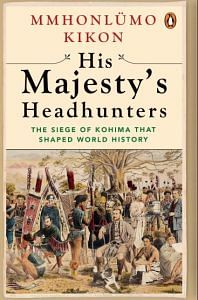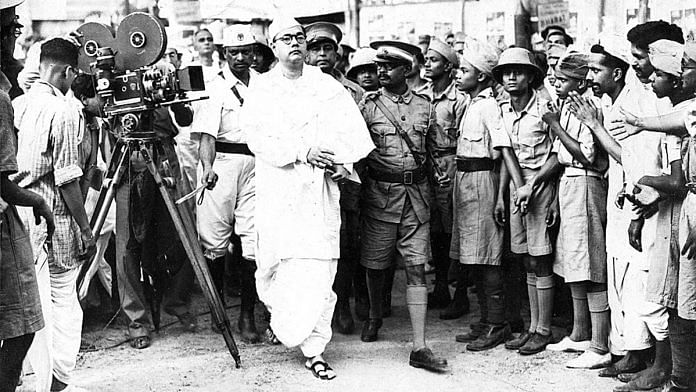It is rumoured in the Naga villages that the Japanese passed through during their arduous journey to Kohima that a tall, bearded man wearing a round frame glass accompanied Lt Gen. Sato in his campaign. As Sato smoked while soaking in the huge tin container of a bathtub outside his residence in Kigwema, the tall, bearded man, who looked like he was from north India to the villagers, was chatting with him all the time. The secret visit of Bose has become part of the local folklore. During his reported stay at Kigwema, Viketu Kiso is said to have been his interpreter. Legends aver that Bose came and stationed at a village called Ruzaho, some 75 kilometres from Kohima, and stayed with an interpreter by the name of Poswuyi Swuro.
At the time of their interview in 2017, they were both aged ninety-four and ninety-six years, respectively, and both claimed to have been interpreters for Bose at that time. Bose is known to have requested the Nagas to support the efforts of the Japanese soldiers. “Don’t fear the Japanese soldiers. They have come to drive out the British. The Japanese are here for the Naga welfare and Indian welfare. If they do any harm, report immediately to the General.”
The role of Bose in the Battle of Kohima was to support the Japanese in mobilisation of the people. Bose had formed the Indian National Army (INA) and was seen as a revolutionary by the British. The intelligence agencies of the Commonwealth saw Bose’s INA as the ‘Japanese Indian Force’ for his collaboration with the Japanese. Gen. Mutaguchi saw Bose as a ‘significant factor’ in the U-Go offensives.
Operation U-Go offensives included a major attack deep within India, Calcutta and beyond. The Japanese intended to use the service of Bose to enter India although an outright invasion was not in the mind of the high command in Japan. By the time he arrived with his tired soldiers at Kigwema, Sato saw some of the villagers had already moved towards the forest in search of shelter from the war. There were vegetables to be bought from them and rations to be garnered, with or without the currency they carried. There are records which suggest that they carried money to buy food. The invading forces used what is called the Japanese Rupee, printed in Burma and issued by the Japanese government during the war. What has been called the Japanese rupee is the currency note issued by the Japanese government during the invasion of Southeast Asia during World War II. The currency notes were used extensively by the Japanese military authority and for a while, they were used to replace the local currency used in territories captured by the invading troops.
The Japanese Rupee was issued when its troops occupied Burma (Myanmar) after 1942. The Japanese advanced to Mandalay (Burma) on 21 May 1942 and literally forced the British to retreat into territories located within the British-controlled side of India. Till the time of the Allied forces’ campaign in 1944, Burma was ruled by the Japanese. In 1942, the Japanese-issued currency notes were introduced to Manipur and parts of Naga inhabited territories as they invaded these territories. When the Japanese began capturing territories, its troops confiscated all currency notes in circulation in these territories.
At the end of the Second World War, the same currency lost all value and those who possessed it discarded it or it was confiscated by the authorities. In Manipur, the British authorities were helped by volunteers of the Manipuri monarch and other organizations who supported the Allied forces as opposed to those who were hand-in-glove with the Japanese through the INA volunteers. Many in Manipur used to keep the same currency as wartime souvenirs after hiding it from those who were tasked with the responsibility of confiscating them. Now, many of these notes can be found in both private and public museums as curated items. Plenty of such printed currency was used in Manipur and Nagaland. Surviving veterans and those who participated in or saw the war had these currency notes in their possession.
The invading Japanese, perhaps in their dream of successfully swaying the result of the war in their favour, wanted to overrun the monetary economy of western South-East Asia, including Burma, modern-day Myanmar. In Manipur, there were sections of people who helped the British authority burn thousands of these Japanese Rupees after a warning was notified.
There are few oral accounts left of how the Nagas reacted to the march of the Japanese. The bearded man who appeared at Kigwema and Ruzazho is still a mystery to many people. Whispers in the kitchen and around the paddy field mumble the name of Subhas Chandra Bose, INA supremo. Could it be so? The INA, under Bose, was definitely a part of this campaign, but many fiercely stand by the truth of his visit. The whispers die, but the legends remain.
The bald, bearded man with round Gandhi frame spectacles had to keep his identity hidden for fear of being caught by the British. Or he simply did not want his presence known. It should, however, be noted that there are government of India-endorsed publications that say that Subhas Chandra Bose was indeed in Nagaland.
A brochure issued by the Ministry of Tourism, New Delhi, called the ‘Incredible India – Legacy of Freedom’, noted the travel itinerary of Netaji Subhas Chandra Bose. It says that Netaji stayed at Ruzazho in Phek district of Nagaland. Named after two lakes, Ruzazho is a beautiful village surrounded by magnificent hills. During the INA campaign against the British in 1944, the government of India brochure stated that Netaji liberated the village and made it the operational base headquarters of the INA. Subhas Chandra Bose stayed for ten days in this village, and over 1000 Naga youths reportedly joined him in the campaign against the British. ‘The house in which Netaji lived and the wooden cot on which he slept during his stay in Nagaland are preserved at Ruzazho Village. The love and respect for Netaji are reflected in the local folklore and songs’, says the brochure.
 This excerpt from Mmhonlümo Kikon’s ‘His Majesty’s Headhunters: The Siege Of Kohima That Shaped World History’ has been published with permission from Penguin Random House India.
This excerpt from Mmhonlümo Kikon’s ‘His Majesty’s Headhunters: The Siege Of Kohima That Shaped World History’ has been published with permission from Penguin Random House India.



